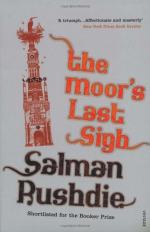|
This section contains 768 words (approx. 3 pages at 300 words per page) |

|
SOURCE: "Extravagant, Madcap Vision of an Indian Clan," in The Christian Science Monitor, February 7, 1996, p. 13.
In the following review, Rubin remarks that "the Moor's outlandish friends, family, and enemies may begin to look a little more familiar than we'd like" in The Moor's Last Sigh.
Salman Rushdie's latest novel, The Moor's Last Sigh, is an extravagant, tragicomic vision of a world exploding with violence, madness, and corruption. Set in the author's native India (where it has been banned, along with Rushdie's "The Satanic Verses," which earned him a Muslim death sentence), this bizarre saga of a larger-than-life family is narrated by the last surviving member of the colorful clan.
Moraes Zogoiby, known as "Moor," is descended on his mother's side from the da Gamas, wealthy spice traders of Portuguese-Christian extraction. His father's clan, the Zogoibys, are members of a Jewish community in South India, although according to family...
|
This section contains 768 words (approx. 3 pages at 300 words per page) |

|


